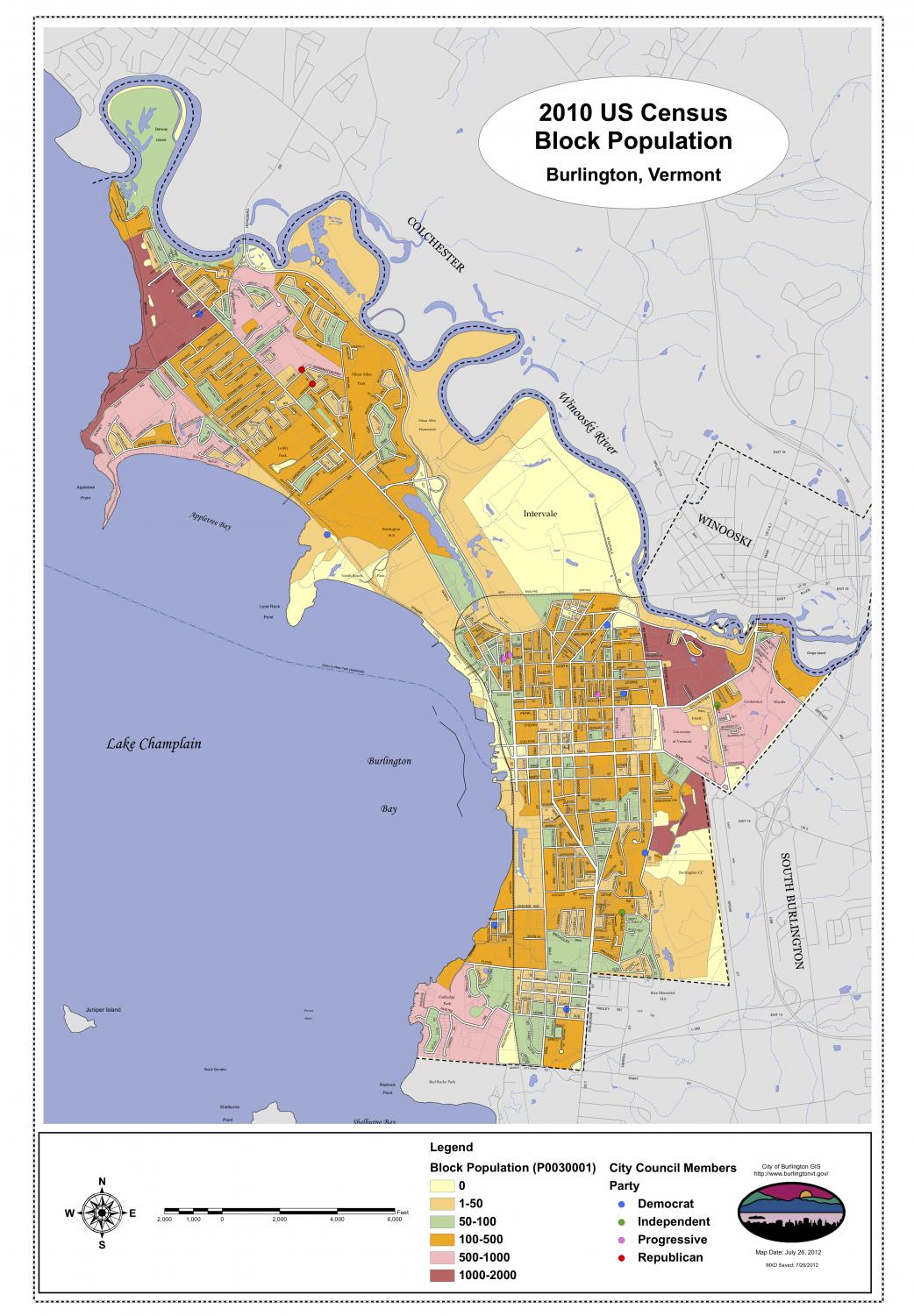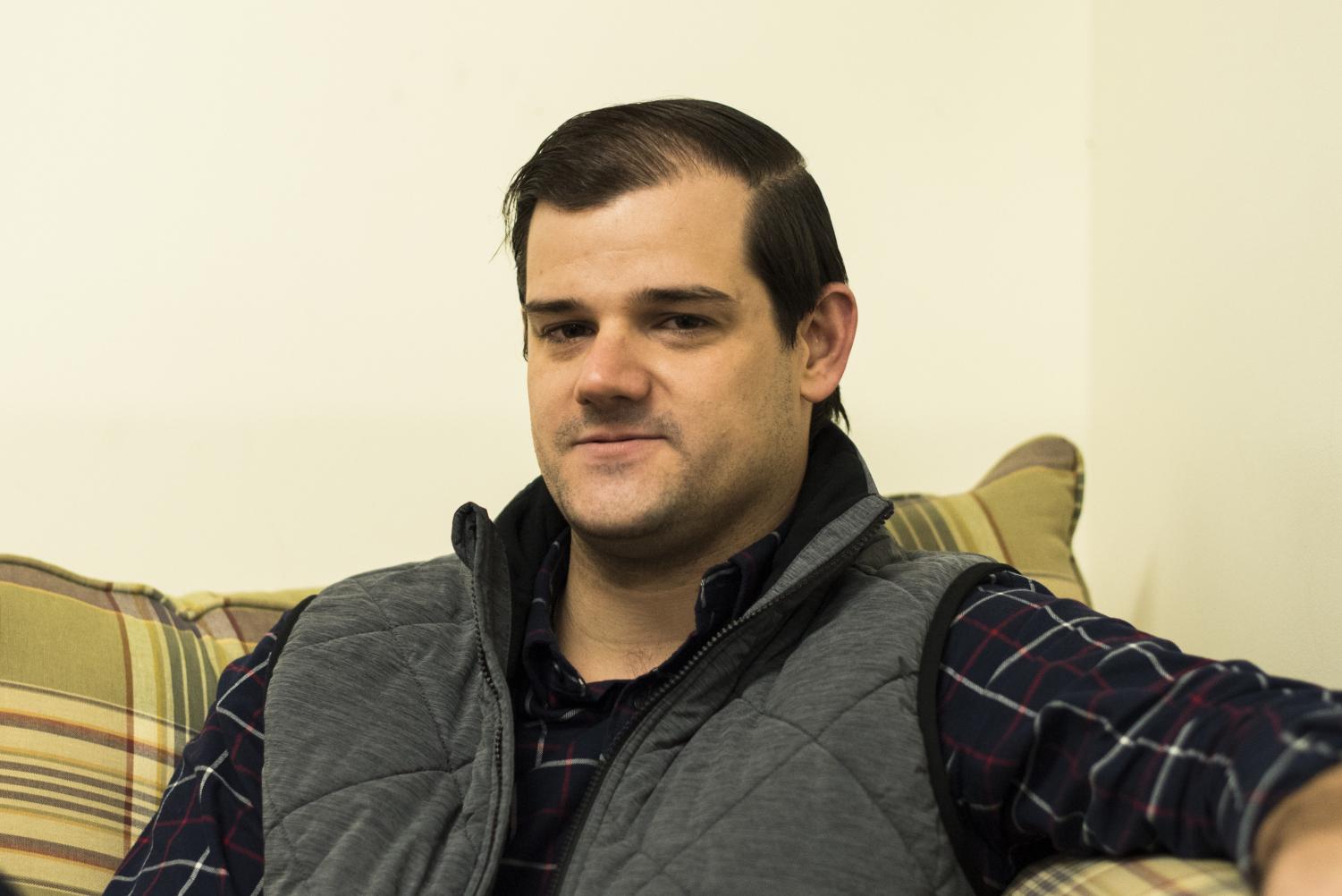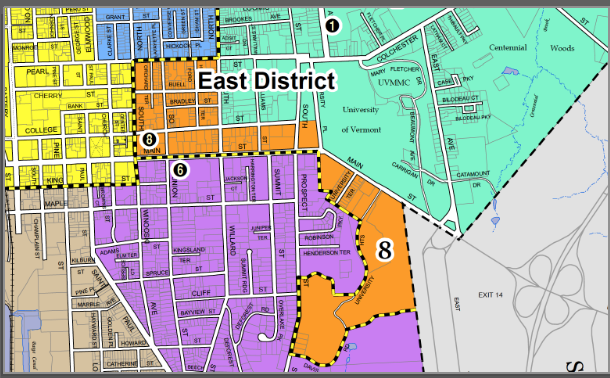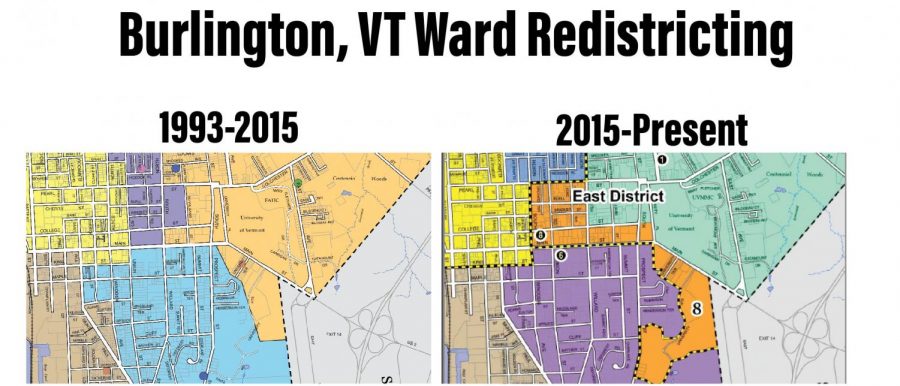Photo illustration by Kate Vanni
Left: a map of the wards the city of Burlington used from 1993 until 2015. Right: The new wards adopted by the city.
“A gerrymandered student ward.” How Burlington’s Ward 8 got its shape
February 26, 2020
Five years after the city of Burlington redrew its voting districts, a city councilor who helped make that decision said she’s left with regret.
“It felt gross to be a part of it,” said Rachel Siegel, who was a city councilor for Ward 3 at the time. “It was one of the worst experiences of my life, but also the most educational.”
Siegel was a part of the Redistricting Committee that was made up of four city councilors and nine representatives from different ward neighborhood planning assemblies.
The committee met from 2012-13 to decide how to rebalance the wards and their representation.
The plan they chose, which was approved in 2014 by Burlington residents, created an entire ward of student voters.
“It’s pretty much a gerrymandered student ward,” said Joan Shannon, who worked on the Burlington Redistricting Committee and was the president of the city council at the time.
Gerrymandering is a redistricting of voting districts to the advantage of one party or disadvantage of a group, according to Webster’s New World College Dictionary.
A rising student population in Ward 1 created an imbalance in power, residents and city councilors weren’t comfortable.
They had to choose whether to take power away from permanent residents or give more power to a growing student population.
Redrawing the map

After the results of the 2010 census came out, it was discovered that the wards that made up Burlington at the time had too much of a population imbalance.
Meaning, as UVM’s student population grew, the number of people who represented them did not, while the population in other wards decreased, their representation didn’t change, Shannon said.
After the census is taken, states are required by law to redistrict in order to make sure that citizens are guaranteed “one man, one vote,” depending on the population of their ward.
“There was a real possibility of a lawsuit,” she said. “We could have been sued by a voter who could claim that they didn’t have equal representation on the council since the numbers were so far out of whack.”
Wards are allowed to have deviations, or the percentage between an ideal population that represents everyone equally and the current population.
Legally, that number has to be within 10% in order to prove that people are being equally represented.
According to data collected by the city, in 2010, Ward 1 had a deviation of 25.3%, while Wards 5 and 7 had deviations of -16.1% and -10.9%.
James Langan, who was a citizen on the Redistricting Committee, said the center of the problem was the ward most of UVM once called home.
“Ward 1 was the center of it because that’s who was being underrepresented as of 2010,” Langan said.
Langan said another issue was the conflicts between what was considered the student ward and the New North End.
“There were folks in the old North and new North that didn’t want to be the sort of losing representation in the council,” Langan said.
The Redistricting Committee reviewed a number of plans, but the one that was brought to the full city council, and eventually to the voters of Burlington, was a hybrid model.
“That’s where the hybrid came in, of having eight representatives from the wards, four representatives from the districts, which got the council size down to 12 city councilors,” Shannon said.
While a ward is a legally defined area, a district spans a greater amount of space and covers numerous wards. For example, Wards 1 and 8 make up the East District.
After the plan was approved by voters in March 2014, the redistricting went into effect in March 2015.
While redistricting, the committee faced challenges in how they would draw the lines across the city.
“It’s contentious because what you’re doing, you’re redrawing power and there are different ways that we could have morale,” said Adam Roof, who is the current City Councilor for Ward 8.

Adam Roof has been the City Councilor for Ward 8 since 2015.
The committee had to decide how many councilors there would be in total, each representing an equal amount of people in their ward.
They considered raising the number of councilors to 16, keeping it at the current number 14 or going back to 13 councilors, which was done before the 2010 census.
“The numbers had grown in Ward 1 faster than the numbers in Ward 7,” Siegel said. “It would have been a very simple mathematical conclusion to revert to 13 counselors.”
Part of the challenges the committee faced in redrawing the lines for Burlington, was that some councilors were not willing to give up what they saw as theirs.
“It was more city councilors wanting to include one of the neighborhoods that they had represented to remain in their ward,” said Max Tracy, who has been city councilor for Ward 2 since the redistricting process.
Siegel said when it came time to vote on a plan, the committee members were afraid of making the wrong decision but were also afraid of the legal consequences that could fall on the city.
“I think it was a fear-based decision,” Siegel said.
Looking back on that vote, Shannon said she still stands by her decision.
“I definitely voted no,” she said. “I think we had better options than that.”
For Siegel, who ended up being the deciding vote, she said that she had to go against her principles.
“It was like the implication of voting for what I actually wanted was that we would get something that I wanted even less if I voted for the middle ground,” she said. “So I chose the lesser of two evils.”
Consequences

A section of the new map Burlington uses to determine its wards and districts. Half of UVM’s campus has been split and now makes up Ward 8.
Five years later, as the new divisions have played out, the changes the redistricting caused have become more clear.
For Ward 6 City Councilor Karen Paul, she lost part of her ward. UVM’s Redstone campus and Redstone lofts both used to make up the edge of Ward 6, and now they are in Ward 8, she said.
Additionally, candidates running to represent Ward 8 are faced with having to figure out how to effectively campaign despite UVM policy.
That policy, set by UVM, says that candidates are not allowed solicitation or campaigning within residence halls or staff areas. This includes door-to-door canvassing, a popular way of campaigning.
“It’s hard to really run a campaign in Ward 8, given that so many of your potential voters are behind locked doors that you’re prohibited from accessing,” Tracy said.
Roof has been Ward 8 representative since the changes went into effect in 2015. He has had to figure out ways to connect with student voters that don’t violate UVM policy.
“When there’s a problem like that, you work your way around it,” he said. “I’m a big believer in meeting people where they’re at, and if I can’t meet them where they live, you get it anywhere else.”
While some who helped make the decision to create Ward 8 regret that move, for Roof, it’s been a positive change.
“We have a more acute opportunity for young people and students to have either a seat at the table or have their voices heard,” Roof said.
The U.S. census is due to be taken again this year, and with those new numbers comes the discussion of redistricting yet again, Shannon, Tracy, Roof and Paul all said.
“These conversations around student voice and youth participation are going to be at the heart of that,” Roof said.
With the new census, the members of city council are hopeful that they can correct what happened in 2015.
“Hopefully with the census taking place this year and then the redistricting that follows we can begin to correct some of that and make the boundaries a little bit more balanced with including more neighborhoods,” Tracy said. “I think that will yield better results.”

Lea Terhune • Feb 29, 2020 at 5:10 pm
You interview and feature a photo of the incumbent candidate in this election, but not the Ward 8 challenger, Jane Stromberg. That s not responsible journalism. She is a strong candidate and given the difficulty of reaching students at UVM, you gave one candidate a distinct advantage. There’s still time to tell us what Jane thinks about this election.
A key point missed in this article is that Council created the so-called 8/4 compromise and had the option of rejecting it. Threats of law suits by the City Attorney are bullying intimidation frequently applied when the mayor is putting his thumb on the scale. Council could have voted on the 16 councilor option recommended by the Redistricting Committee
The 16 councilor option is more direct democracy. It gives each councilor a smaller number of residents to represent, making door to door, face to face campaigning doable. The 8/4 compromise was the opposite, distancing councilors from those they represent. Of course, 12 councilors are easier for mayor and parties to control than 16 councilors close to their residents.
Michael Long • Feb 28, 2020 at 12:43 pm
My recollection is that Ward 1 was grossly underrepresented and that the “solution” left it still underrepresented, though within the legal parameters. This suggests that fair representation was not the objective, which is, of course, always the case by definition when gerrymandering.
The primary objective was to maintain the overrepresention in wards that had enjoyed it for quite some time so that these wards did not lose councilors while others gained them.
Redistricting is a messy process, ethically and politically, especially since elected officials themselves have such power over it, but gerrymandering is never right for democracy.